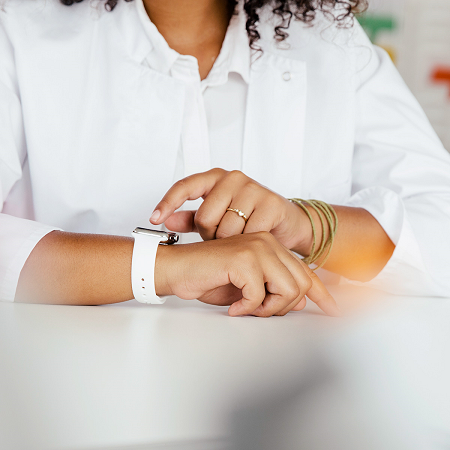5 Ways Wearables Are Improving the Way We Shop
 Source: Discover
Source: Discover
If you think we don’t have room for another connected device in our pockets or purses, you might be right.
Placing one on our wrist is another story.
Need proof? Last year, 39.5 million Americans older than 18 used wearable devices, an increase of 57.7 percent compared with 2014, according to eMarketer. This rise is estimated to continue, with 81.7 million adults expected to be using wearables by 2018.[1]
The reasons for wearables’ growing popularity vary, including giving consumers the ability to better monitor their health and fitness and keeping them organized when on the go. Wearable devices, such as Apple Watch and others, are also improving the way we shop by receiving communication and alerts and making payments hands-free. On the retailer side, wearables allow brands to send targeted messaging to customers in-store and offer discounts to improve conversion.
“Tech-savvy retailers willing to invest in marketing through wearable technology can place themselves a step ahead of competitors as these devices grow in popularity,” says Soumya Chakrabarty, director of research and development at Discover. “For example, brands can push out notifications that send shoppers personalized offerings, increasing conversion and driving interest and loyalty.”
Streamlining Product Search by Pairing Smartwatches with Beacons
One way to engage with wearables in stores is by coupling them with strategically placed beacons. In this scenario, a customer heads to his or her local retailer and is seeking a sales associate for help with a question or to locate a product. If this retailer is leveraging beacons placed throughout the store, shoppers armed with wearables don’t have to worry about finding staff, since they can use their devices to navigate a store’s aisles and access valuable information. A quick scan of an item followed by a few taps of her watch, and she can retrieve such information as sizing, materials or location.
Streamlining Payments
With the advent of Apple Pay, Android Pay and Samsung Pay, mobile payments are gaining popularity among consumers and the technology to accept these forms of payment are becoming available at major chains and smaller retailers alike. Wearables could change the game by making these transactions even easier, favoring a flip of the wrist over pulling out a phone.
According to an eMarketer study, 48 percent of consumers said they would use a wearable device if it could make an in-store payment, and 67 percent said they would prefer to use a wearable device over a smartphone to make an in-store payment.[2]
Better Dissemination of Discounts
Thanks to post-purchase opt-ins, the average shopper now receives regular emails about online and in-store deals and sales. But for those steering their shopping carts to the cash register, pulling out their smartphone to scan through hundreds of emails to find an offer can be difficult, if they remember to search for these mobile coupons at all. Wearables could fix that by enabling consumers to take advantage of discounts by swiping their wrists over a scanner at the time of purchase, applying the coupons to their bills during checkout.
Targeted Messaging
While push notifications and beacon-enabled messaging aren’t new, the growing success of reaching shoppers via these technologies is partially thanks to wearables. That’s because wearables don’t require shoppers to pull out their phones to get these messages. What’s more, these technologies give a retailer access to shoppers across channels, reducing cart abandonment. A retailer can alert a customer to items left in their online shopping carts as they pass the physical store. This retailer also could send a customer a message letting them know that an item they were viewing online is in stock at the store nearby.
Better Overall Customer Experience
In its 2014 study, The Wearable Future, PWC found that 72 percent of consumers said it was very important for wearable technology to improve customer service. The most vocal group was busy parents—76 percent of whom said they wanted wearable tech to make shopping a more pleasant, efficient experience.[3]
Smart retailers targeting these shoppers may turn to wearables to tackle customer service gaps and increase the efficiency of their workforces. By arming sales associates with devices that can check inventory, pull up product specifications and even take payments, retailers can get rid of the need to go to the back of the store or visit a separate computer terminal to perform these tasks, creating a more seamless retail experience.
“As brands are considering their end-to-end customer journey, they should think about how to integrate these devices into their overall marketing strategy,” adds Chakrabarty. “Wearables offer merchants a fast and simple way of interacting with customers on-the-go and can push out relevant, personalized messaging in order to enhance customer loyalty.”
Related articles:
This article was brought to you by Discover Network. For more insights into consumer trends and the world of payments, visit Discover Network Perspectives.
[1] eMarketer, “Wearable Usage Will Grow by Nearly 60% This Year”, Oct. 28, 2015
[2] eMarketer, “Wearables: The Next Mobile Payment Device?”, March 3, 2015
[3] PWC, “Wearable Technology Future is Ripe for Growth – Most Notably among Millennials”, October 21, 2014











































